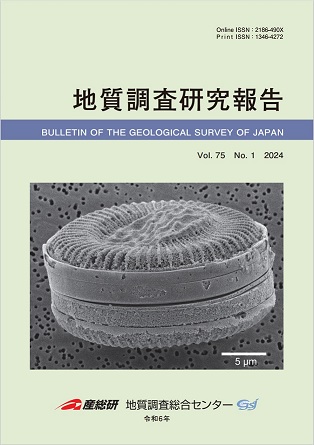
- Issue 1 Pages 1-
- |<
- <
- 1
- >
- >|
-
Tomoya ABE, Kiyohide MIZUNO, Tomonori NAYAArticle type: research-article
2024 Volume 75 Issue 1 Pages 1-19
Published: March 12, 2024
Released on J-STAGE: March 14, 2024
JOURNAL FREE ACCESSTo construct chronostratigraphy of the Pleistocene sediment beneath the Nishimikawa Plain, tephra beds in five boring cores (GS-HKN-1, TK No.1, GS-NSO-2, ISJ, and N214 cores) drilled in the plain were correlated to widespread tephra based on the petrographic characteristics of tephra layers, and major and trace element composition of volcanic glass shards. The HKN1-v27 tephra in the GSHKN-1 core, the NSO2-v27 tephra in the GS-NSO-2 core, and the ISJ-v30 tephra in the ISJ core were corresponded to Ks10 tephra (MIS 13~MIS 14) or Ks18 tephra (MIS 15). The TK1-v18 tephra and the TK1-v23 tephra in the TK No. 1 core were correlated to Aso-3 tephra (MIS 5e) and Kkt tephra (MIS 9), respectively. The N214-v30 tephra in the N214 core was correlated to Ata-Th tephra (MIS 7). Based on the correspondence between the age of widespread tephra and MIS, depositional period of facies unit of Pleistocene sediment in each boring core were estimated as follows. The unit 7 in the GS-HKN-1 core, the unit N2-1 in the GS-NSO-2 core, and the unit 1 in the ISJ core were MIS 13~MIS 15. The unit C in the TK No. 1 core, the unit 1 in the N214 core, and the unit B in the TK No. 1 core, were MIS 9, MIS 7, and MIS 5e, respectively. According to these results, the ages of Pleistocene sediment beneath the plain were varied with core site, and it is interpreted as a complex stratigraphic sequence of in the plain.
View full abstractDownload PDF (4286K) -
Tomonori NAYA, Tomoya ABE, Kiyohide MIZUNOArticle type: research-article
2024 Volume 75 Issue 1 Pages 21-59
Published: March 12, 2024
Released on J-STAGE: March 14, 2024
JOURNAL FREE ACCESSDiatom assemblages recovered from three drilling cores, GS-HKN-1, GS-NSO-2 and TK No.1 cores, drilled in the Nishimikawa Plain, Aichi Prefecture, Japan, are investigated. The diatom assemblages from each core comprise a series of repeating assemblages dominated by marine and brackish-water diatoms and freshwater diatoms. Diatom zones were defined in each core (zones HKN1-1 to 8, NSO2-1 to 4 and TK1-1 to 6, respectively, from lower to upper), and the diatom assemblages in each zone were documented and their depositional environments were also estimated. The age of the marine intervals, which consist mainly of marine and brackish-water diatom assemblages, and their correlation with oxygen isotope stages (MIS) indicate that at least nine marine intervals are intercalated in the sediments of the Nishimikawa Plain over the past million years. The last occurrence of Cyclotella stylorum in the late Early Pleistocene, Lancineis rectilatus in MIS15 or MIS17, Diploneis cf. bombus in MIS11, and Paralia fenestrata only occurs above MIS19. The biostratigraphy of these diatom fossils can provide a useful stratigraphic reference for the Pleistocene in this area. Microscopic photographs of the key diatom fossils are illustrated, together with a list of references and illustrations for the basis of identification.
View full abstractDownload PDF (6607K)
- |<
- <
- 1
- >
- >|